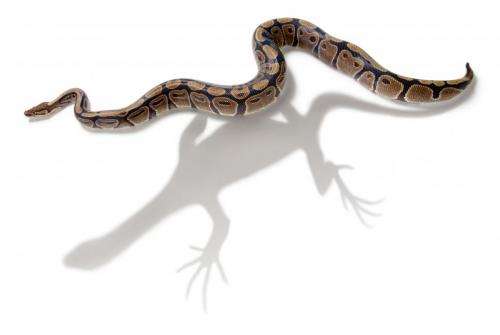Study puts new perspective on snake evolution

Snakes may not have shoulders, but their bodies aren't as simple as commonly thought, according to a new study that could change how scientists think snakes evolved.
Paleobiologists Jason Head of the University of Nebraska-Lincoln and P. David Polly of Indiana University Bloomington found distinctions among snakes' vertebral bones that matched those found in the backbones of four-legged lizards.
Rather than snakes evolving from a lizard ancestor to a more simplified body form, the researchers say their findings suggest other animals gained more complex vertebral columns as they evolved.
The study provides new perspective on Hox genes, which govern the boundaries of the neck, trunk, lumbar, sacral and tail regions of limbed animals. The functions of Hox genes previously were thought to have been disrupted in snakes, resulting in seemingly simplified body forms.
Snakes differ from mammals, birds and most other reptiles because they lack forelimbs, shoulder girdles and breastbones. It was thought that when they lost their limbs, they also lost the regional distinctions that separated their backbones into neck, trunk, lumbar and other regions.
Yet when Head and Polly examined the shapes of individual vertebral bones in snakes, lizards, alligators and mice, they found snakes had regional differentiation like that of lizards.
"If the evolution of the snake body was driven by simplification or loss of Hox genes, we would expect to see fewer regional differences in the shapes of vertebrae," Head said. "Instead, what we found was the exact opposite. Snakes have the same number of regions and in the same places in the vertebral column as limbed lizards."
Not only did Head and Polly find that snakes were as differentiated as lizards, but when they compared regions in snakes with Hox gene expression, they found the two matched.
"This suggests that Hox genes are functioning in the evolution and development of the vertebral column in snakes, but instead of patterning distinct, rib-less regions like the neck and lumbar spine of mice, they control more subtle, graded changes in shape," Head said.
When combined with information from fossils, these findings indicate that the direction of snake evolution is the opposite of what had been concluded from developmental genetics alone, Head and Polly say.

"Our findings turn the sequence of evolutionary events on its head," Polly said. "It isn't that snakes have lost regions and Hox expression; it is that mammals and birds have independently gained distinct regions by augmenting the ordinary Hox expression shared by early amniotes."
Amniotes are the group of vertebrates that include reptiles, mammals and their predecessors.
"Snakes have a lot more vertebrae compared to lizards and they have lost the shoulder girdle, but they are just as regionalized," Polly said.
Head and Polly reached their conclusions using a method called geometric morphometrics and a regression-based analysis of the size and shape of vertebral structures. To determine where one segment ends and the next begins, they use a statistical method called maximum likelihood estimation.
"Analysis of gene functions are necessary, but not sufficient in studying evolutionary transitions," Head concludes. "In order to fully understand the mechanisms by which new body forms evolve, it is crucial to study the anatomy of modern and fossil organisms."
The study was published online Jan. 5 by the journal Nature.
More information: Evolution of the snake body form reveals homoplasy in amniote Hox gene function, Nature, DOI: 10.1038/nature14042
Journal information: Nature
Provided by University of Nebraska-Lincoln




















